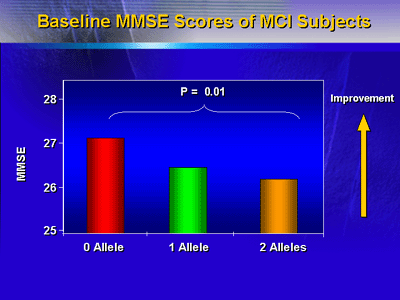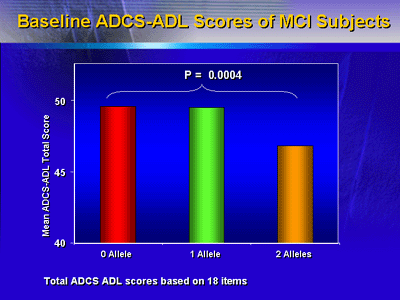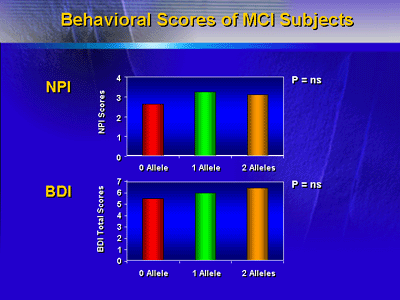| In
a cohort of patients with mild cognitive impairment, patients
with the APOE E4 allele had significantly greater deficits in
cognition and activities of daily living. Subjects carrying
this allele also had reduced hippocampal volumes. The APOE E4
status of a patient with mild cognitive impairment may provide
important prognostic information.
In patients with mild cognitive impairment, the rate of conversion
to clinical dementia is as high as 20% per year. There is
strong evidence linking the presence of the E4 allele of apolipoprotein
E (APOE) and clinical dementia. Some investigators think APOE
allele status may provide insight into a patient’s prognosis.
The large, ongoing InDDEx study (Investigation in the Delay
to Diagnosis of Alzheimer’s Disease with Exelon) provides
an opportunity to investigate this hypothesis.
The large multicenter, placebo-controlled
double-blind InDDEx study includes individuals with mild cognitive
impairment. The primary endpoint is the effect of rivastigmine
on the time to clinical diagnosis of dementia. In addition
to taking cognitive and behavioral assessments, investigators
have conducted genotyping to identify patients with 0, 1 or
2 APOE E4 genes.
Genotyping results for 494 patients in the
InDDEx study revealed that 9% (44 patients) carried 2 APOE
E4 alleles, while 31% (154 patients) had 1 APOE E4 allele,
and the remaining 60% had none.
Those patients with APOE E4 alleles had relatively
worse cognitive scores at baseline. For example, baseline
Mini-Mental State Exam scores were relatively lower in patients
with 2 APOE E4 alleles versus patients with no APOE E4 alleles.

Likewise, baseline Alzheimer’s Disease Assessment
Scale-cognitive subscale (ADAS-cog) scores showed the same
pattern. Patients with 2 APOE E4 alleles were significantly
more impaired at baseline compared with patients who had no
APOE E4 alleles. This was true for the overall ADAS-cog score
as well as sub-item scores, including word recall, delayed
word recall and word recognition.
Other measures of cognition, including Buschke
free and cued recall, as well as NYU delayed paragraph recall,
again showed increasing problems with increased number of
APOE E4 alleles. On the other hand, the cognitive findings
at baseline did not carry over to measures of behavior or
depression. There were no significant differences according
to presence or absence of APOE E4 alleles.
Interestingly, in this study, patients with
APOE E4 alleles had a clear deficit in activities of daily
living scores versus those patients who did not. Physicians
do not expect patients with mild cognitive impairment to have
significant impairments in physical function, Dr. Farlow noted.

Investigators also evaluated hippocampal volume
in a subgroup of 272 patients. Hippocampal atrophy is one
factor that may predict conversion from mild cognitive impairment
to dementia.
Magnetic resonance imaging data showed a highly
significant difference according to APOE E4 allele status.
There was evidence of considerably more atrophy in the group
of patients that had 2 APOE E4 alleles at baseline, compared
with the non-APOE E4 population.

Dr. Farlow said these study results are consistent
with previous work suggesting that patients with the APOE
E4 genotype are much more likely to progress to dementia earlier
as opposed to patients who do not have this genotype.
The data may also support the hypothesis that
APOE E4 status may have considerable prognostic value in patients
with mild cognitive impairment. Future analysis of the InDDEx
study data will include conversion rates to clinical dementia.
This will show whether APOE genotype is a valid marker for
prognosis in patients with mild cognitive impairment.
|